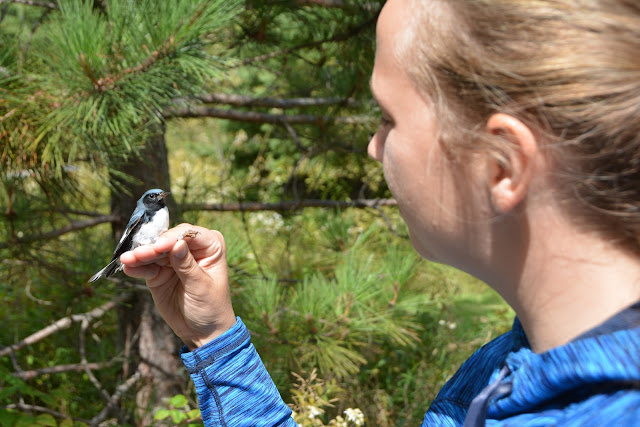 |
| Joanne Hamilton writer bander extractor |
From the City
Oh sweet Canada Canada Canada. The charming song of the White-Throated
Sparrow pierces the air, drowning out the panting of my dog Tigi. We’re on a
walk in a managed forest, an old pine plantation that’s been left to develop
into mixed woods. A pond was built here to act a water reserve for fires, now
it houses spring peepers. Everything was managed at some point, it still is,
the forest has been torn down, replanted, earth moved and soil taken.
But it’s still
habitat, an oasis nestled in between towns and cities. Ten minutes west and the
town of Newmarket sprawls out with a labyrinth of roads, malls, cars, and
people. To the east farms stretch out into Uxbridge, remnants of a life that’s
disappearing under the wave of housing developments.
And here in these
woods migrants sing and chirp all around us. They flit high up in the trees as
they make their way northwards to breed. In only a few weeks their beautiful
song will disappear. At the time I had no idea I myself would be leaving these
woods to head north, to the Hillardton Marsh.
Spring turned into
summer and a date to arrive was set. I was excited and nerve-wracked. I had
spent my whole life living in cities. Newmarket, Guelph, and Toronto. Suburbia
and the monoliths of glass and steel were what I was most familiar with. I had
only ever travelled as far north as Algonquin Park having only scraped the edge
of the boreal forests.
As summer progressed
my nerves got worse as the date for my departure approached. What would it be
like? Would they like me? Would I be able to extract as well as I needed to?
What if I couldn’t handle the bugs? I was plagued with self-doubt and wondering
if I should just stay put. I knew very little about the marsh and had only
spoken on the phone with Bruce and handful of times. His e-mails gave me cold
comfort, often scatter-brained and occasionally indecipherable, I honestly
wondered what I had gotten myself in to. Glenn and Theresa reassured me that
going up was a good decision and that I would be fine. Glenn remined me to go
for the birds if for nothing else.
So I did.
 |
| Brown creeper |
And there are lots of
birds at the marsh. Cranes, sparrows, warblers, flycatchers, and ducks. I’ve
seen so many new species here since I arrived, not only of birds but of frogs
too. The city can be quiet at times, devoid of much birdlife and there are
hardly any frogs. Spring peepers and leopard frogs if I am lucky. But here,
mink, green, bullfrog, and wood frogs!
 |
| wood frog photo by Joanne Hamilton |
And White-Throats.
Here I was on their breeding grounds, hearing their song in the morning as part
of the dawn chorus. Alongside them were many other beautiful warblers,
sparrows, and flycatchers. All breeding. It was fascinating to watch as the
hatch-year birds grew and parents finished moulting. In a blink of an eye a
tidal wave of birds heading south descended on the marsh, and all the babies
disappeared.
 |
| photo by Joanne Hamilton |
I think about all
these young birds heading towards the south, towards cities. Towers of glass
and steel will cover the horizon and a glow of light will block out the stars.
The road network will become a maze as they leave the North. The dawn chorus
will have more than just birds and frogs. Sirens, traffic, planes, and
thousands of people working will join them. All of them getting ready for the
up-coming winter, for a change of season, a new part of their life.
 |
| Hairy Woodpecker |
Banding Totals for
September 6, 2017
Banded Total: 118 Number of Species: 23
Hairy Woodpecker 1
Yellow-bellied Flycatcher 1
Alder Flycatcher 1
White-throated Sparrow 18
Slate-coloured Junco 1
Lincoln’s Sparrow 4
Swamp Sparrow 12
Rose-breasted Grosbeak 1
Red-eyed Vireo 7
Philadelphia Vireo 1
Nashville Warbler 12
Tennessee Warbler 2
Yellow Warbler 5
Myrtle Warbler 2
 |
| young golden crowned kinglet |
Western-palm Warbler 10
Ovenbird 2
Northern Waterthrush 1
Mourning Warbler 1
Common Yellowthroat 15
Wilson’s Warbler 3
American Redstart 4
Grey Catbird 1
Brown Creeper 1
Golden-crowned Kinglet 2
Veery 2
Swainson’s Thrush 7
American Robin 1
 |
| female yellow rumped warbler |





























